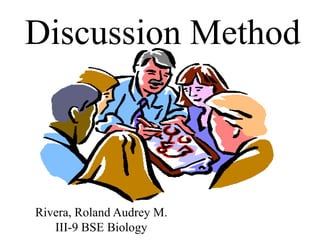
Discussion Method
- 1. Discussion Method Rivera, Roland Audrey M. III-9 BSE Biology
- 2. Coin Relay
- 3. Materials:
- 4. Procedure: 1.Form 2 groups with 5 members. 2.5 centavo coin must be pass using toothpick inside the mouth up to the last member of the group. 3.The first group to finish the activity will be the winner.
- 5. Discussion Method To engage in an orderly verbal interchange and to express thoughts on a particular subject
- 6. Goals of conducting discussion. Help students increase their confidence on sharing their own ideas
- 7. Help students become more mature, self- guided, and interdependent individual Able to live and work with others in a cooperative, productive and responsible way
- 8. Types of Discussion: one student or team of two gives report on a topic followed by questions and discussions by the entire class. Report
- 9. finding good idea to a certain situation. The one who had the best solution is called the brain child Brainstorming
- 10. formal speeches made by two opposing teams Debate
- 11. class simulates a courtroom as a judge, attorney, jury members, recorders and others Jury trial
- 12. consist of facilitator, material manager, recorder and reporter. Roles may be changed but not frequently Group discussion
- 13. The Boy who Cried Wolf
- 14. 1. What did the shepherd boy do? 2. Why are villagers angry with the boy? 3. Based from the story how will you apply the lesson you have learned? 4. How does the boy improve his trick when he does it a second time? 5. At the end of the story, the boy has lost the trust of the townspeople. How can the boy solve this problem and gain the trust of the townspeople again? 6. Why do the villagers not believe the boy the third time he “cries wolf”?
- 15. Questions that develop higher- level thinking process in a discussion
- 16. Knowledge question recalling of specific information’s such as terms and facts What did the shepherd boy do? Comprehension question describe main ideas in their own words Why are villagers angry with the boy?
- 17. Application question application of what have they learn Based from the story how will you apply the lesson you have learned? Analysis questions describe patterns, cause and effect, comparison and contrast How does the boy improve his trick when he does it a second time?
- 18. Synthesis question contribution of new idea At the end of the story, the boy has lost the trust of the townspeople. How can the boy solve this problem and gain the trust of the townspeople again?
- 19. Evaluation question opinions and judgement Why do the villagers not believe the boy the third time he “cries wolf”?
- 20. Tips in Conducting Discussion: Appropriate use of physical space U-shape seating Circle seating
- 22. Role of teachers Express own opinions Encourage all students that all answers and opinions are valued Value silence/wait time, the resulting discussion may be much more creative and productive Provide them the material to be used
- 23. Establish rules Tell the students that they must not talk or contribute idea until they have been recognize Let the students respond to one another’s idea and let them support their own answers If students hesitate, provide them with cues without providing the answer Simplify/rephrase the question if they find it difficult Attend to all students avoid favouritism
- 24. Support the ideas of the students Responding to Students answer-praise the students Responding to Students opinion-seek clarification, ask them to support their answer Responding to Student’s incorrect/incomplete answers-give cues to help them. Tell them that their answer might be correct for other questions
- 26. In a one whole sheet of paper write an essay about proper way of conducting a classroom discussion. Addressing to incoming teachers.
- 27. References: • Arends, R.I. (1997). Classroom Instruction and Management. U.S.A. McGraw-Hill Companies. Pages 199-221 • Calderon, J.F. (1998). Principles and Practices of teaching. Quezon City, Philippines. Echanis Press. Pages 205-210 • Eby, J.W. and Kujawa E. Reflective planning, teaching and evaluation:k-12. (1994). New Jersey, U.S.A. Prentice Hall. Pages 190-203 • Gunter, M.A. et.al. (1995). Instructio: a models approach. 2nd edition. A Simon and Schuster Company. Pages 174-193, 200 • Kellough, R.D. et.al. (1993). Middle School TeachingMethods and Resources. New York, U.S.A. Macmillan Publishing Company. Pages 197-203
- 28. Write T if the statement is True and F if the statement is False.
- 29. 1.Discussion is the most common to middle school teacher. 2.Discussion helps students to grow physically 3.Reporting is a type of discussion 4.Group discussion can be classified into two 5.Bloom’s developed the process of questioning to develop higher level of thinking
- 30. Enumeration: Give 2 seating patterns in appropriate use of space Give 3 roles of a teacher in a discussion
